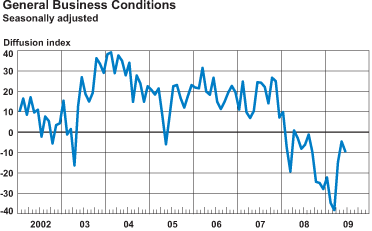June 2009 Report
Survey Indicators
Seasonally Adjusted

The Empire State Manufacturing Survey indicates that conditions for New York manufacturers continued to deteriorate in June, at a moderately faster pace than in May. The general business conditions index fell 5 points, to -9.4. The new orders index remained negative and near last month’s level, while the shipments index fell 6 points to -4.8. The inventories index declined and remained well below zero. Price indexes were negative but modestly higher than in May, and employment indexes stayed below zero. Future indexes were generally positive and continued to rise, conveying an expectation that conditions should improve over the next six months. Both the capital spending and technology spending indexes rose into positive territory for the first time since October of last year.
In a series of supplementary questions, manufacturers were asked about their capital spending plans for 2009 relative to their actual spending for 2008, both overall and for a few broad categories of capital (see Supplemental Report tab). Similar questions had been asked in June 2008 and June 2007. In the current survey, 56 percent of respondents reported reductions in overall capital spending in 2009, while just 20 percent reported increases. These results contrast fairly markedly with those of the June 2008 survey, which showed nearly as many respondents reporting increases (32 percent) as decreases (36 percent). The 2009 results differ even more sharply from those of the 2007 survey, which showed far more firms reporting increases than reductions. Respondents were also asked about the extent to which various factors contributed positively or negatively to their planned changes in capital spending. Nearly 55 percent of those surveyed cited sales and demand trends as a negative factor, while just 21 percent cited these trends as a positive factor. The other major driver of spending reductions for 2009 was cash flow or balance sheet position. Estimated capital spending for calendar 2009 across all respondent firms averaged $1.9 million, down from $2.5 million in 2008—a 24 percent decline—while the median decreased from $500,000 to just $275,000, a drop of more than 42 percent.
General Business Conditions Index Falls Modestly
The general business conditions index fell several points from last month’s level, dropping to -9.4, but remained well above the string of deeply negative readings observed in the October-March period. This month, 28 percent of respondents reported that conditions had improved, compared with 23 percent last month, while 38 percent of respondents reported that conditions had worsened, up from 28 percent. After rising above zero last month, the shipments index retreated to -4.8. The unfilled orders index, at -10.3, was little changed. The delivery time index rose a few points to -10.3, and the inventories index fell to -25.3.
Prices Continue to Fall, but Pace Slows
The indexes for prices paid and prices received were negative for a seventh consecutive month, but they rose from May levels. The prices paid index advanced from -11.4 to -5.8, with 10 percent of respondents reporting higher prices and 16 percent reporting lower prices. The prices received index climbed 15 points to -12.6, with 6 percent of respondents receiving higher prices and 18 percent receiving lower prices. Employment indexes were little changed from last month’s low levels. The index for number of employees inched up 2 points, to -21.8, while the average workweek index, at -21.8, was little changed.
Six-Month Outlook Continues to Improve
Future indexes continued to rise, conveying an expectation that conditions should get better over the next six months. The future general business conditions index advanced 4 points, to 47.8, its highest level in nearly two years; 61 percent of respondents expected conditions to improve over the next six months. The future new orders index, at 45.8, suggested similar optimism, as did the future shipments index at 48.7. Input prices were expected to rise, while selling prices were expected to fall; the future prices paid index was positive, at 10.3, and the future prices received index was negative, at -5.8. The index for future number of employees surged from 0.7 last month to 16.1—a fourth consecutive monthly increase from February’s record-low
-29.3. The capital expenditures index rose into positive territory for the first time since October, climbing 13 points to 11.5, and the technology spending index also rose above zero, to 1.2.










